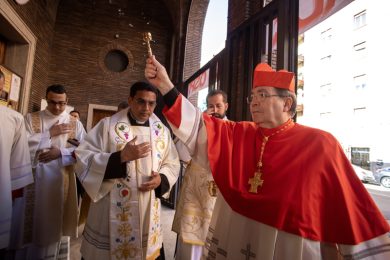Q: Please explain what we celebrate on the coming feast of the Holy Cross on Sept. 14. Thank you.
A: The feast of the Exaltation of the Holy Cross derives from Empress Helena’s discovery of the Lord’s cross in Jerusalem on Sept. 14, 320. Later, churches which had a major relic of the cross (Jerusalem, Constantinople, Rome) had a custom of showing this relic to the faithful on Sept. 14 in a solemn ceremony called the “Exaltation,” “lifting up,” of the cross; this ceremony gave the feast its name.

Thirty years ago I was a doctoral student in liturgy at the University of Notre Dame. I lived for a while in the rectory at St. Hedwig Church, a Polish parish, in South Bend, Indiana. Across the street was St. Patrick Church, in an Irish parish. One July evening, I observed the two golden crosses atop the spires at St. Patrick’s shining brightly, glowing in the light of the setting sun. It was breathtaking.
In a way, that is what the feast of the Exaltation of the Holy Cross does. It takes the cross of Jesus — an instrument of torture and death — and raises it in the bright sunlight of Christ’s paschal mystery, God’s Easter plan for our salvation in the dying and rising of Jesus, in which we share through baptism. And the cross of Christ, aglow in the light of God’s love for this world, becomes the holiest of all signs.


Over a thousand years ago, an artist crafted what is known as the Cross of Lothair. One side of the cross is an assertion of imperial status and wealth. At the center of the gems and gold filigree is a cameo portrait of the Emperor Augustus. He is wearing a fine robe and an olive wreath, the symbol of military victory. On the other side there is only a flat piece of silver, on which is engraved an outline drawing of the crucifixion.
There we see the King of the Jews wearing a crown of thorns. Its beauty makes the front of the cross look worldly and pretentious. The message is clear: our salvation comes not from power and wealth, but from the humility we glimpse in the cross of Christ. God accomplished our salvation in weakness and suffering.
To St. Paul before his conversion, a powerful Messiah would have been so much simpler to accept than a crucified one. Yet, Paul came to understand the saving power of Christ’s death on the cross. Thus, after quoting an ancient Christian hymn that declared, Christ “humbled himself, becoming obedient unto death,” Paul adds: “even death on a cross” (Philippians. 2:8). So important was the death of Christ for Paul that it was the one thing he boasted in, the one thing he preached.
St. Paul could never forget the cross. Neither can we. We keep it. We display it and honor it. We treasure the cross and all that it represents. The cross reminds us of the greatest love in our lives, the love of God for us. God loved us so much that God gave us the only Son, that we might have eternal life through his cross.
It is easier to remember that love when we see a cross, especially on the walls of our Catholic churches, schools and homes. If we hold on to the cross, we come to believe that God indeed could have loved us that much. As we face our sufferings and even accept them, our faith empowers us to unite our sufferings to the one who suffered for us, the one lifted up on the cross. We keep the cross to remember. In faith, we lift high the cross on the feast of the Exaltation of the Holy Cross so that we may live in the power of its triumph every day.
Benedictine Father Michael Kwatera, a monk of St. John’s Abbey in Collegeville, serves as the abbey’s director of liturgy. Please send your questions on liturgy to him at mkwatera@csbsju.edu or at St. John’s Abbey, P.O. Box 2015, Collegeville, MN 56321-2015.






















